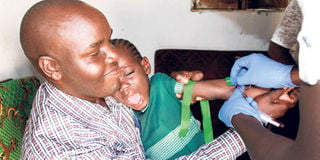Children tested for lead poisoning tests

A girl in pain as medical personnel extracts blood samples from her arm. Residents of Owino Uhuru in Mombasa, who were affected by lead-poisoning, received free treatment
What you need to know:
- The four-day tests would target children because of the risks lead poisoning poses to their health in future, said Dr Etiang.She said lead affects a child’s development and the “body’s neurological and cognitive functions.
- “The findings will act as guidelines to the agencies that closely work with the government, including the National Environmental Management Authority (Nema) and the Health ministry.”
- A multi-sectorial report would be compiled and results made public through relevant government agencies.
Health ministry officials Wednesday started carrying out lead poisoning tests on children at informal settlements near a battery recycling factory in Mombasa County.
Blood samples were drawn from the children aged between one to five for the tests. The medics are targeting 100 children at Owino Uhuru and a similar number at Bangladesh.
The tests come in the wake of the factory’s closure three months ago, after it was established that the smelter had violated environmental and health laws.
“We want to determine the clinical effects on humans near the factory, detect symptoms and the effects of lead on the surrounding environment,” said Dr Nancy Akoit Etiang, a lead investigator at the Department of Disease Prevention and Control.
Though the factory was shut down after a visit to Owino Uhuru by a Senate committee last year, the investigators want to establish whether the environment was still getting contaminated.
The four-day tests would target children because of the risks lead poisoning poses to their health in future, said Dr Etiang.She said lead affects a child’s development and the “body’s neurological and cognitive functions.
“Lead causes poor performance, abdominal problems, constipation and poor attention. Higher levels can damage the brain, liver, kidney and nerves,” she added.
Dr Etiang said the findings would be compared and intervention measures put in place. The same would also help in policy formulation.
“The findings will act as guidelines to the agencies that closely work with the government, including the National Environmental Management Authority (Nema) and the Health ministry.”
Previously, blood samples were taken after the villagers complained of discharge of effluent and fumes from the plant.
“The 50 blood samples were taken last September to the Government Chemist for analysis and the report is yet to be submitted to the Senate.
“The samples taken were from the very sick and those that live near the factory,” she said.
AID QUEST FOR JUSTICE
A multi-sectorial report would be compiled and results made public through relevant government agencies.
“Individuals will get their own results and interventions too,” she added.
Ms Phyllis Omido, the director of Centre for Justice, Governance and Environmental Action, said the families staying next to industries expected the results to aid their quest for justice.
Previous medical reports revealed that samples from locals had lead that was above the recommended World Health Organisation (WHO) standards, she said.
“This is a step towards better things. We will move to court to seek compensation for the affected families from the factory and government agencies for their negligence in allowing the factory to operate,” she added.
Mr Alfred Ogolla Mulo, a village elder at Owino Uhuru, asked what became of the findings of the tests carried out by the medical team sent by the Senate.
“The tests were done but, until now, we are not sure whether the truth will be known. Is the government sincere or is it hoodwinking us?” Mr Mulo asked.
Other bodies involved in the exercise are the Kenya Medical Research Institute, Moi University, Jomo Kenyatta University of Agriculture and Technology, Government Chemist and Mombasa County Government.




